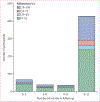Factors associated with the uptake of and adherence to HIV pre-exposure prophylaxis in people who have injected drugs: an observational, open-label extension of the Bangkok Tenofovir Study
- PMID: 27866873
- PMCID: PMC11317911
- DOI: 10.1016/S2352-3018(16)30207-7
Factors associated with the uptake of and adherence to HIV pre-exposure prophylaxis in people who have injected drugs: an observational, open-label extension of the Bangkok Tenofovir Study
Abstract
Background: Results of the randomised, double-blind, placebo-controlled Bangkok Tenofovir Study (BTS) showed that taking tenofovir daily as pre-exposure prophylaxis (PrEP) can reduce the risk of HIV infection by 49% in people who inject drugs. In an extension to the trial, participants were offered 1 year of open-label tenofovir. We aimed to examine the demographic characteristics, drug use, and risk behaviours associated with participants' uptake of and adherence to PrEP.
Methods: In this observational, open-label extension of the BTS (NCT00119106), non-pregnant, non-breastfeeding, HIV-negative BTS participants, all of whom were current or previous injecting drug users at the time of enrolment in the BTS, were offered daily oral tenofovir (300 mg) for 1 year at 17 Bangkok Metropolitan Administration drug-treatment clinics. Participant demographics, drug use, and risk behaviours were assessed at baseline and every 3 months using an audio computer-assisted self-interview. HIV testing was done monthly and serum creatinine was assessed every 3 months. We used logistic regression to examine factors associated with the decision to take daily tenofovir as PrEP, the decision to return for at least one PrEP follow-up visit, and greater than 90% adherence to PrEP.
Findings: Between Aug 1, 2013, and Aug 31, 2014, 1348 (58%) of the 2306 surviving BTS participants returned to the clinics, 33 of whom were excluded because they had HIV (n=27) or grade 2-4 creatinine results (n=6). 798 (61%) of the 1315 eligible participants chose to start open-label PrEP and were followed up for a median of 335 days (IQR 0-364). 339 (42%) participants completed 12 months of follow-up; 220 (28%) did not return for any follow-up visits. Participants who were 30 years or older (odds ratio [OR] 1·8, 95% CI 1·4-2·2; p<0·0001), injected heroin (OR 1·5, 1·1-2·1; p=0·007), or had been in prison (OR 1·7, 1·3-2·1; p<0·0001) during the randomised trial were more likely to choose PrEP than were those without these characteristics. Participants who reported injecting heroin or being in prison during the 3 months before open-label enrolment were more likely to return for at least one open-label follow-up visit than those who did not report injecting heroin (OR 3·0, 95 % CI 1·3-7·3; p=0·01) or being in prison (OR 2·3, 1·4-3·7; p=0·0007). Participants who injected midazolam or were in prison during open-label follow-up were more likely to be greater than 90% adherent than were those who did not inject midazolam (OR 2·2, 95% CI 1·2-4·3; p=0·02) or were not in prison (OR 4·7, 3·1-7·2; p<0·0001). One participant tested positive for HIV, yielding an HIV incidence of 2·1 (95% CI 0·05-11·7) per 1000 person-years. No serious adverse events related to tenofovir use were reported.
Interpretation: More than 60% of returning, eligible BTS participants started PrEP, which indicates that a substantial proportion of PWID who are knowledgeable about PrEP might be interested in taking it. Participants who had injected heroin or been in prison were more likely to choose to take PrEP, suggesting that participants based their decision to take PrEP, at least in part, on their perceived risk of incident HIV infection.
Funding: US Centers for Disease Control and Prevention and the Bangkok Metropolitan Administration.
Copyright © 2017 Elsevier Ltd. All rights reserved.
Conflict of interest statement
Declaration of interests
We declare that we have no competing interests.
Figures

Comment in
-
Commitment issues: PrEP adherence in injecting drug users.Lancet HIV. 2017 Feb;4(2):e52-e53. doi: 10.1016/S2352-3018(16)30208-9. Epub 2016 Nov 18. Lancet HIV. 2017. PMID: 27866872 No abstract available.
References
-
- Joint UN Programme on HIV/AIDS. AIDSinfo: world overview. http://www.unaids.org/en/dataanalysis/datatools/aidsinfo/ (accessed May 5, 2016).
-
- WHO. HIV/AIDS: people who inject drugs. http://www.who.int/hiv/topics/idu/en/ (accessed May 5, 2016).
-
- Choopanya K, Martin M, Suntharasamai P, et al., for the Bangkok Tenofovir Study Group. Antiretroviral prophylaxis for HIV infection in injecting drug users in Bangkok, Thailand (the Bangkok Tenofovir Study): a randomised, double-blind, placebo-controlled phase 3 trial. Lancet 2013; 381: 2083–90. - PubMed
-
- Thigpen MC, Kebaabetswe PM, Paxton LA, et al. Antiretroviral preexposure prophylaxis for heterosexual HIV transmission in Botswana. N Engl J Med 2012; 367: 423–34. - PubMed
Publication types
MeSH terms
Substances
Associated data
Grants and funding
LinkOut - more resources
Full Text Sources
Other Literature Sources
Medical
Miscellaneous

